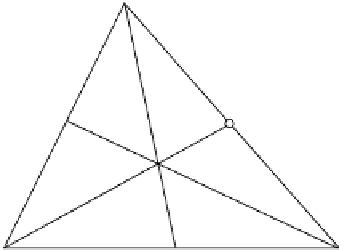Graphics Reference
In-Depth Information
vertices
A
,
B
and
C
respectively, are concurrent (intersect at a common point)
if, and only if
AC
C
B
·
BA
A
C
·
CB
B
A
=1
Figure 11.1 shows such a scenario.
There are various ways of proving this theorem, (see
Advanced Euclidean
Geometry
by Alfred Posamentier) and perhaps the simplest proof is as follows.
Figure 11.2 shows triangle ∆
ABC
with line
AA
extended to
R
and
BB
extended to
S
, where line
SR
is parallel to line
AB
. The resulting geometry
creates a number of similar triangles:
A
C
BA
CR
AB
∆
ABA
∆
RCA
:
⇒
=
(11.1)
B
A
CB
=
AB
SC
∆
ABB
∆
CSB
:
⇒
(11.2)
C
B
¢
A
¢
P
A
B
C
¢
Fig. 11.1.
The geometry associated with Ceva's Theorem.
C
S
R
B
¢
A
¢
P
A
B
C
¢
Fig. 11.2.
The geometry for proving Ceva's Theorem.
















